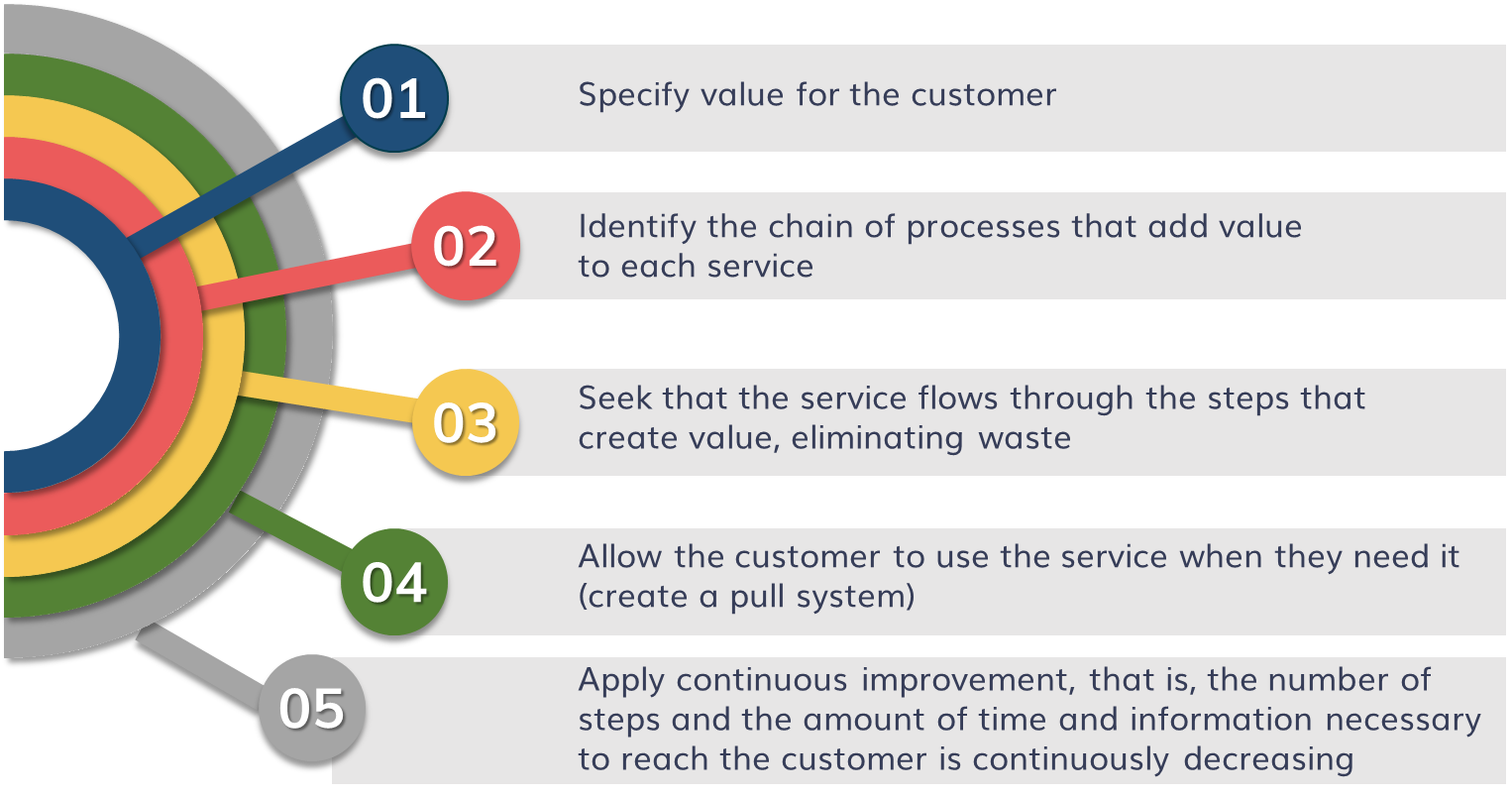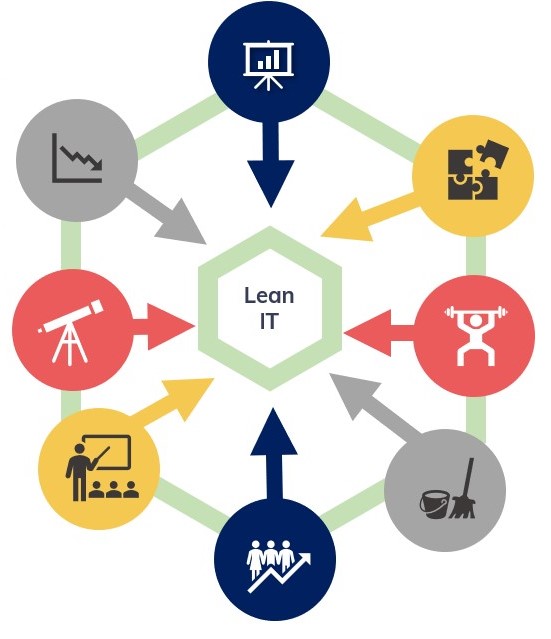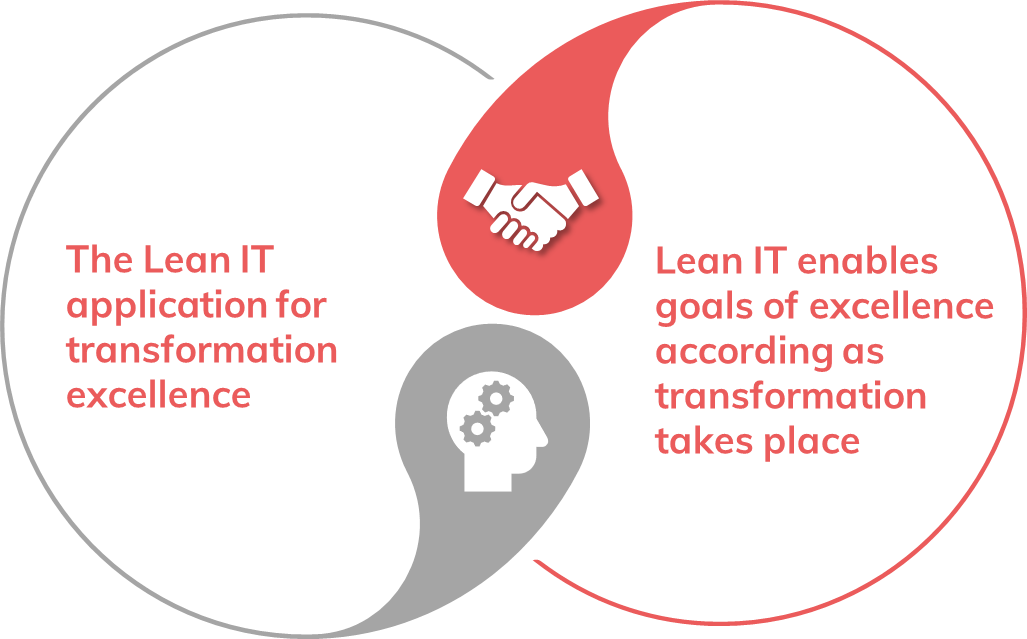
Lean IT: objectives, key concepts and real examples
Lean IT is the extension and adaption of lean manufacturing (a management model widely used in industrial processes) to TI environments. Its central concern, applied in the IT context, is the elimination of waste, in the act of consuming the service (external users / customers) and also in the act of providing the service (IT). And on the other, to maximize the value offered to customers and users.
The implementation of Lean IT is a continuous process that begins with the identification of waste points, then with the prioritization of improvement actions and finally the application and control of these improvements. To be concrete, this philosophy must be thought in the long term as it can take years before the lean principles become intrinsic to the culture of an organization.
Lean philosophy principles
JP Womack and Daniel Jones defined in their book The machine that changed the world, five principles of Lean Manufacturing that are the fundamental basis of this philosophy.

Lean IT main concepts
Product time to market is no longer an asset, and good services are no longer enough to distinguish our brand. Lean is, in essence, a way of thinking and behaving. It revolves around the following key concepts:

- Cost reduction. Thanks to the implementation of this philosophy, losses and costs that are not strictly necessary are reduced.
-
Focus on long term goals. It is fundamental to implement the Lean IT philosophy, be clear about the long term objectives of the company. This will help to make decisions both strategic and in operational areas easier. The improvements that are detected must be focused on these objectives and thus establish priorities.
- Staff training. A very important factor that ensures the success of Lean IT implementation are the work teams and their respective leaders. For this reason, it is very important to train staff on this philosophy and thus ensure its correct implementation.
- Involving everyone. One of the benefits of the Lean methodology is that it makes all the employees of the same company work together for the same purpose. This is generally an incentive to reduce any probability of failure.
- Improve customer value. Lean seeks to satisfy the customer by increasing the business value with a lower financial cost, reducing waste.
-
Continuous improvement in small steps. The KAIZEN CYCLE seeks to improve the process with existing resources and means, that is, creativity prevails over investment and is based on small continuous and incremental improvements.
- Reduction of peaks and falls in production. Reducing the time to execute tasks, we eliminate excess production since it generates waste and losses. The probability of producing a defective item and inactivity time is considerably reduced too.
- Reduce waste. Lean IT promises to identify and eradicate waste that otherwise contributes to poor customer service, higher business costs and lost employee productivity.
Areas of application of Lean IT
Applying Lean IT implies involving both the organization's management and all its employees. Therefore, it is really important that the people who work implementing this philosophy have a vocation of service and a desire to improve, seeking creative formulas and that they are in the constant search for the excellence.
It should be clear that Lean IT is not studied, but it is applied. We are not looking at tools or a definition of best practice processes, we are looking at a philosophy, a way of working, which means improving every day. Lean IT provides a generic improvement approach, with a special focus on behaviours and attitudes. Lean IT applies to the entire IT domain, from requirements to maintenance.
For apply Lean IT, we must focus on two main points:

a) The Lean IT application for transformation excellence
Most companies and especially those IT-related are facing transformation and reinventing themselves to position themselves in their sector. The market is moving faster than ever, it has become more and more demanding and the competition continues to challenge us in every step of the way. Time to market no longer assures us of success, and being the first is no longer enough, being the smartest is a key factor using all our resources, making the best use of the information we have within a framework of continuous improvement. To achieve this, the way of thinking and the way of acting are the essence to guide the roadmap of transformation. Our efforts must focus on a strong commitment to improve, optimize our service and the way we offer it. The vocation of service is what should move us, but with a clear objective, which is to seek excellence in everything we do.
b) Lean IT enables goals of excellence according as transformation takes place
The key concepts for this are to improve the customer experience, through continuous improvements that allow us to react and launch efficient and fast solutions. In this way, we will increase our agility and ability to adapt with small gestures and actions that provide immediate added value, reducing the loss of time, costs and resources. That is to say, think of a small gesture, that does not involve practically cost, that has an easy implementation and ensures customer loyalty.
4 Real examples of Lean IT
Bank
We are a bank and we have a client who meets the requirements for a pre-granted loan. We detect that this customer withdraws money from an ATM in China (for example), or that his movements indicate that he is on vacation in that country.
Initiatives. 1. Taking advantage of the fact that the customer is at the ATM and needs money, he is offered the credit that he already has pre-granted. 2. Offer credit payment alternatives.
Achievements. 1. The customer feels that he can go to the bank in case he needs money at any time. 2. The customer will feel more comfortable spending money that he had not planned to use and thus enjoy more of the attractions in the foreign country. 3. The customer will be happy that the bank detects their needs and gives them personalized options.
Insurance company
We are an insurer, and our client who is on a road trip in another country has an incident and must call a tow truck.
Initiatives. 1. Offer them a free roaming service so they can track the tow truck.
Achievements. 1. The client will feel accompanied in a moment of anguish and uncertainty. 2. The client can tell his friends about his good experience with the insurance company, which could encourage them to take out insurance. 3. The customer, seeing the effectiveness of the road crane insurance, will be encouraged to take out another insurance.
Production company
We are a production company and every month we have the same batch error, the reactive solution that is applied is to ask the person who is on duty to relaunch it. The problem is that the following morning we have mismatched accounting positions, lost transactions that must be investigated and balanced.
Initiatives. 1. Instead of reactively solving the incident, we carry out a corrective activity in which we definitively solve it. 2. Have a contingency plan online and visible to all staff, identifying the different incidents that may occur, distinguishing the different applications and affected areas.
Achievements. 1. Fewer incidents during the duty (one less cost). 2. Fewer teams impacted (one less cost). 3. Minimization of square errors (lower cost, and avoid reputational damage). 4. Detection of incidents that may occur, identifying the best solution and affected people.
Consultancy
We are an IT consultancy. Currently we are in times of COVID or another pandemic, daily three more times of patients go to health centers than in normal times, which has caused large agglomerations of sick patients and collapsed health personnel.
Initiatives. 1. Offering hospitals, health centers and private centers the pre-existing video consultation service, which does not involve a big logistical effort.
Achievements. 1. The influx of patients to hospitals, public and private health centers is reduced. 2. The risks of contagion are minimized. 3. The workload of health staff is reduced. 4. Costs are minimized. 5. Increase loyalty with patients and the health center.
Conclusion
The Lean IT philosophy does not seem very distant from the continuous improvement mechanisms that we traditionally see in other management models such as ITIL, ISO 20,000 or CobiT. The main difference is that Lean IT focuses on providing exactly what is needed (from the customer's point of view), using the minimum of resources and at the right time, depending on the demand for services (do not forget that overproduction or overcapacity in a service is an important source of waste) and in the concept of "micro-change": it is not about organizing a large project of improvement actions, but about achieving an organizational culture oriented towards permanent improvement thanks to the continuous introduction of small improvements and adaptations to customer needs.
In conclusion, by implementing the Lean IT philosophy within an organization, the company can stand out in its sector and thus achieve better efficiency. This is achieved by making small gestures, having a solid long-term strategy, followed by a strong commitment to the level of service, hand in hand with SW monitoring, with well-defined quality indicators, making sure to have benchmarks aligned with the strategy and objectives and last, but not least, do not forget that people are a primary point to achieve it, so staff must be trained, continuously motivated and made part of the achievements obtained.
Co-written by Yelda Muñoz y Marcela Carbón

